Dumbarton Oaks Papers - Volume 64 | 2010
Georgi R. Parpulov - Irina V. Dolgikh - Peter Cowe
Like other volumes listed as “seors.” in what was once the library of Ulrich Fugger (1526–1584), the present Vaticanus Palatinus graecus 209, must have been bought in Venice or Padua at some point between ca. 1550 and 1570. Nothing is known about the earlier history of this manuscript. Written on watermarked paper datable ca. 1355,3 it contains an extensive collection of miscellaneous texts. Since many of these start on a recto, most of folio 284 verso remained at first blank, and was subsequently filled with a short set of instructions for painters thee writing on that page is smaller, but otherwise the same as elsewhere in the book. A number of marginal drolleries may be another sign that the original owner of the Palatinus was interested in art.
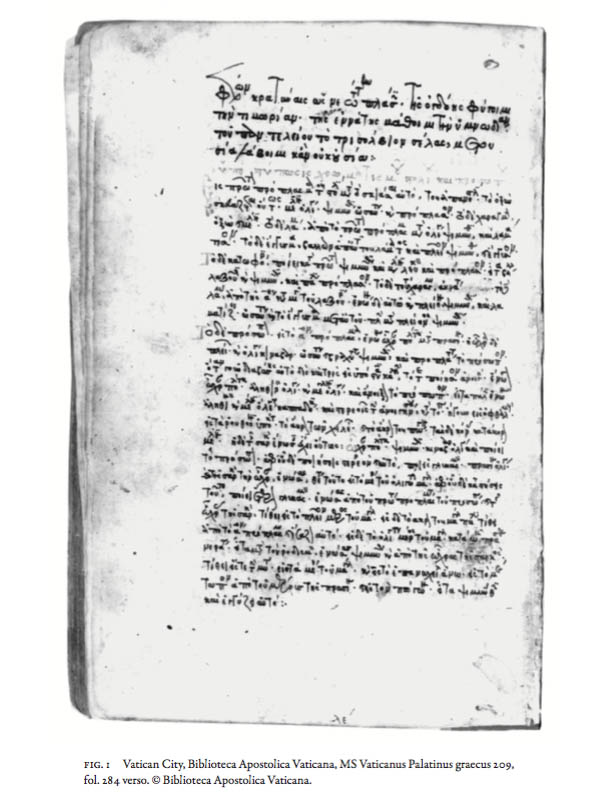
Instruction for Painting Garments and Faces
For the garment’s first undercoat after outlining it, the violet of the outer garment is prepared thus: [add] a little black, the same quantity of white, and lay an under-coat. For the dark folds — violet and black. For the at surface — some of the initial undercoat pigment with a little white, and paint the at parts. For the highlights — taking some of this surface pigment and more white, paint the highlights.
For the inner garment, first make grey [out of] white and black, and lay an undercoat. Then take blue and white, and again lay an undercoat. is undercoat, as it is, is for the dark folds. For the at surface you take the initial blue mixture, add more white to it, and paint the at parts. [Do] the highlights in the same manner with this [mixture], but with even more white.
The face: For the first undercoat, you mix Constantinopolitan ocher (or more ocher with a little cinnabar) and green, as well as a tiny bit of white, and the undercoat for the face is laid [therewith]. A er doing this twice or thrice for a good basis, do the drawing: mix Constantinopolitan ocher with a little purple and a little black, and draw the features. en you mix again purple and black [into] what is known as Cappadocian pigment, and strengthen your drawing at spots such as the eyes, the lower part of the nostrils, the edges of the lips, and the top of the chin. The pupils [of the eyes are done in] pitch black.
The mixture for the flesh consists of the following: Constantinopolitan ocher, white, and a little cinnabar. Paint the face [therewith]. After making it solid as well, do the tints: mix a little green with the ocher [used] for the flesh, and lay it on the narrow sides of the cheeks. After finishing this, make a second tint: mix the initial undercoat pigment for the face with the flesh color, and lay this on the broad sides of the cheeks. At the tops of the cheeks put some of the initial undercoat pigment and even it out. On the narrow sides of the cheeks, toward the edges, [use] watered-down green. After [painting] the pinks, mix white with some of the flesh color and put this on the nose, on the sides of the cheeks, above the upper lip, on the forehead (next to the green), and on the chin. Then you [take] white, and add the highlights.
The demotic vocabulary and loose syntax leave little doubt that the treatise is not a literary composition but reflects actual workshop practice. Being the oldest one of its kind (no other Greek text on iconographic technique predates the seventeenth century), it is, despite its brevity, an important source for studying late Byzantine painting

The Instruction refers almost certainly to panel rather than mural painting, since several operations that it describes make no sense on a plastered surface: the use of lead white (ψιμμύθιον), the repeated application of a single color (διαβάζειν αὐτὸ [τὸ πρόσωπον] δὶς καὶ τρὶς εἰς ὑπόστασην καλήν), and the “evening out” of color (ἰσάζειν αὐτό), which probably means so evening the tonal transitions.
A figure’s outer garment (ἀπανοστολίον), inner garment (κατωφόριον), and face (πρόσωπον) are each painted on a separately laid and differently colored undercoat (πρόπλασμα). The actual painting process consists of layering varying shades of a single color or, rarely, laying upon the principal color a different, complementary one.
The modeling of garments is based on three principal shades: dark folds (χάραγμα), at surface (λάμα), and highlights (ἔ υσμα, also spelled ἔ ισμα). is technique is illustrated by a Palaiologan painting available to us for close examination at the time of writing, viz., the fourteenth-century icon of Saint Andrew in the Walters Art Museum, Baltimore. The dark folds and highlights of the outer garment, as well as the less differentiated shading of the inner garment, where the undercoat itself was left partially visible in the “troughs” of the folds, are both seen on color photographs of this work.
The same icon also illustrates, to the extent to which subtle gradations of color can be separated by the naked eye, the complex method of painting faces, in which the Palatinus text distinguishes undercoat (πρόπλασμα), drawing (ἀνοιγή), principal flesh color (σάρξ), tints (γλυκασμός), pinks (ῥοδισμός), and highlights (ἔ ισμα). Some of these procedures involve distinct hues: the drawing is strengthened in dark “Cappadocian,” the pinks are, not surprisingly, pink, and the highlights are added in white. As part of the tinting, the shadows at the edges of the cheeks are painted with a bit of additional green. (Dark outlines, green shadows, small pink spots, and white highlight brushstrokes are all seen on the face and neck of Saint Andrew in the Walters icon.) The rest is done in ocher, variously mixed with small quantities of green, cinnabar, white, purple, or black to obtain at least six different color shades.
The terms used for two of the seven pigments mentioned in the text point to their origin: the white (ψιμμύθιον) is lead white, while the cinnabar (κινναβάρ), i.e., vermilion, is red mercuric sulphide. The ocher comes in two varieties, Constantinopolitan (πολίτικη) and plain, which are most probably reddish and yellowish earth. In spite of its name, the ἀληθινή may or may not be genuine purple. The words μελάνη, πρασίνη, ὀξύν, and λαζούριον give no clue about the chemical composition of the black, green, violet, and blue.

Our next and principal task is to compare the Palatinus Instruction to similar and possibly related texts on the same topic. Its earliest parallel, discovered by Henry Kahane (1902–1992), is a single sentence from a sermon by Andrew of Crete (d. 740). The homilist extols God’s superhuman creative ability by posing the rhetorical question: Ποῖος ἐν μήτρᾳ ζωγράφος εἰκόνας σκιογραφεῖ, καὶ χρωματουργεῖ ζῷον, καὶ χρόας ἐντίθησι, καὶ γράφει ποιότητας, καὶ λαμματίζει βάθη, καὶ χαρακτῆρα συνίστησι; (“Which painter [can] in the womb outline images, color a living creature, lay on complexions, draw features, paint reliefs, and create a physiognomy?”). It is tempting to see here a description of the consecutive phases of the painting process: the image is first outlined, then filled with color; next, the flesh is painted and the features are drawn upon it; finally, the rounded parts are shaded. However, Andrew’s homily is not an instruction for painters and it is uncertain how precise its meaning was meant to be.
When it comes to technical literature properly speaking, the Palatinus Instruction is paralleled by the corresponding sections (almost identical between themselves) of two post-Byzantine Greek painting manuals: the Hermeneia of Dionysios of Fourna, composed ca. 1729–32,20 and another, anonymous text that must also date from the eighteenth century. We quote in the first place those chapters that mention the painter Panselinos, to whom one attributed in Dionysios’s time the wall painting of the Protaton in Karyes and of the main churches in the Athonite monasteries Vatopedi, Chilandari, and Panteleimon. The Panteleimon murals do not survive, but all the remaining ones are datable between ca. 1290 and ca. 1320. The two texts, then, show how the Palaiologan technique of icon painting was understood in the eighteenth century. The following excerpts from Dionysios, translated here anew, are directly comparable to the Palatinus Instruction.
§ 16. Preparation of Undercoat. By Panselinos
Take [one] dram of white, [one] dram of ocher, [one] dram of the green used for murals, and [one] denk of black. Grind them all together in a marble [bowl], gather them in an inkwell, and if you want to paint flesh, lay an undercoat.
§17. Drawing Eyebrows and Other Facial Features Painted on Icons. By the Same [Panselinos]
Mix black with violet (ὀξύ) and draw (ἄνοιγε) what you want [to paint], thinly at first and strengthening it afterward. Do the pupils and the prominent parts (δύναμες) of the eyelids, eyebrows, and nostrils in pure black. Or, if you want, take [one] dram of umber, [one] dram of bole, stir them in a marble [bowl], and having mixed them, draw (ἄνοιξε) what you want [to paint]. Strengthen the drawing on the prominent parts (δύναμες) with umber only. In the pupils of the eyes and the nostrils put black. is is the Panselinos drawing (ἀνοίγματα).
§18. By the Same: How to Make Flesh Color (σάρκα)
Take [one] dram of Venetian white or of the good French white (which [comes] in balls wrapped in a paper), [one] dram of Venetian ocher (if there is no Venetian ocher, imitate it with another one, similar to it), and [one] dram of cinnabar. . . .
§19. Another [Recipe for] Flesh Color by the Same [Panselinos]
Take [one] dram of white and [one] dram of yellow-red ocher, grind them together, and prepare the flesh color (ποίει σαρκώματα). If you do not have yellow-red ocher, take some other ocher and mix it with a little bole to make it a bit reddish. Then prepare the flesh pigment as explained above, but beware not to make it too red. If your ocher is from Thasos, it needs no bole.
§ 20. Preparation of Tints
Put in a shell two parts of flesh pigment and one part (or less) of undercoat pigment. Mix them and thus make the tints (τὸν γλυκασμόν). Cover with it at first whatever flesh you want to paint. is is how the tints are done.
§21. How to Paint Flesh
After laying the undercoat and drawing the face (or whatever else you want [to paint]), cover it at first with the tints, as described above, applying them thinly (λεπτώντας) on the tops (εἰς τὲς ἄκρες) [of the cheeks and chin] so that they do not stand out (νὰ μὴ χωρίζῃ) against the undercoat. en put the flesh pigment on the prominent parts (τὲς δύναμες) [of the face] and thin it out (λέπτυνε) little by little toward the tints. Pick out (χώριζε) with the flesh pigment all the wrinkles on [the faces of] old men; on [those of] young men, only the eye sockets. Then add to the same flesh pigment a moderate amount of white to make it lighter, put this in the central parts (τὰ θεμέλια) [of the face] where you want to place highlights (νὰ ψιμμυθίσῃς), and apply it very thinly. [Do] the highlights in the same way: thinly at first, and then strengthening the ones that are on the prominent parts [of the face]. is is how the Panselinian painting of flesh (σαρκώματα) is done.
§ 22. The Pinks
Know that in the case of young saints and the Virgin, you have to put the pink (τὸ κοκκινάδι) very thinly in the center of the face, mixing parts (δύναμες) with umber only. In the pupils cinnabar with flesh pigment. Apply bole very of the eyes and the nostrils put black. is is thinly in the shadows (ἴσκιοι) of the hands. Apply thin bole also in the deeper wrinkles of all men, and delineate their other wrinkles, those above the eyebrows, with tints pigment, as described above.
§ 24. How to Color Garments
When you want to color (νὰ λαματίσῃς) garments with whatever pigment you want, take at rst a bit of pigment and white and make a pale color (λευκὸν λάμμα), such as to paint over it the at parts and the highlights (πρῶτον λάμμα καὶ ψιμυθίαν), and lay an undercoat (πρόπλασε) for the garment where you want [to paint it]. en make a deeper shade of the same pigment, draw the folds (ἄνοιξον αὐτό), and thinly paint the shadows (λέπτωσον αὐτὸ εἰς τοὺς ἴσκιους). en make the pigment whiter than the under- coat and paint the at surface (λαμμάτισον αὐτό). Add highlights on the prominent parts (ψιμύθισε τὲς δύναμες); be careful not to put white in the shadows. is is how natural coloring (τὰ φυσικὰ λάμματα) is done.
As mentioned, the anonymous Greek manual differs very little from that of Dionysios:
§13. Undercoat.By Panselinos
Take one dram of white, one dram of ocher, one dram of the green used for murals, and one denk of black. Grind them all together in a marble [bowl], gather them in an inkwell, and, if you want to paint flesh, lay an undercoat. Then mix black with violet (ὀξύ) and draw [the features] (ἄνοιγε): make them thin at first and strengthen them afterward. Do the pupils and the prominent parts (δύναμες) of the eyelids, eyebrows, and nostrils in pure black.
§ 14. Drawing Eyebrows [and] Other [Features] at Are to Be Painted on Icons
Take umber and bole, stir them, grind them well in a marble [bowl], and, having mixed them, draw (ἄνοιξε) what you want [to paint]. Strengthen the drawing on the prominent parts (δύναμες) with umber only. In the pupils of the eyes and the nostrils put black. This is the Panselinian drawing (ἀνοίγματα).
§15. How to Make Flesh Pigment(σάρκα). By Panselino
Take one dram of white [. . .], one dram of ocher [. . .], and one dram of cinnabar. . . .
§17. How to Make Tints for Painting Flesh
Take two parts of that same flesh pigment and one part (or less) of undercoat pigment. Mix them in a shell to make the tints (τὸν γλυκασμόν). en paint with them whatever flesh you want to paint. in out the tints in the transitions (τὰ λεπτώματα) to the flesh pigment. en put flesh pigment on the prominent parts (τὰς δυνάμεις) [of the face], and thin it out into the tints. Pick out (χώριζε) the wrinkles on [the faces of] old men; on [those of] young men, only the eye sockets. en add to the same flesh color a moderate amount of white to make it lighter and put this in the central parts (τὰ θεμέλια) [of the face] where you want to place highlights (νὰ ψιμμυθίσῃς), applying it very thinly. [Make] also the highlights thin at first, and then strengthen the ones that are on the prominent parts (εἰς τὲς δύναμες) [of the face]. is is how Panselinos’s painting of flesh (σαρκώματα) is done.
§18. Where and How to Put the Pinks
Apprentice, know that in the case of young saints and the Virgin, you have to put the pink (τὸ κοκκινάδι) in the center of the face, mixing cinnabar with esh pigment, and you have to apply it very thinly. Apply bole very thinly also in the shadows (ἴσκιοι) and the drawing of the hands, as well as in the deeper wrinkles of old men, so that these do not become too red; if the wrinkles do not stand out (ἀν δὲν στέκουν), apply the bole twice or thrice, each time waiting for it to dry [first] so that you do not scrape o with your bone stylus (κονδύλιον) the bole underneath.
§ 20. How to Color Garments
Apprentice, when you want to color (νὰ λαματίσῃς) garments like Panselinos, make [the principal pigment for] them. Then take some of this mixture, put it in another shell, add white, and make a pale undercoat (λευκὸν προπλασμόν), such as to paint over it the surface and the highlights (ἕνα λάμα καὶ τὲς ψιμμυθίες). en draw the folds (ἄνοιξέ το) in indigo and in red, diluted as much as you can. If you want, add also some of the pigment for the undercoat, and then draw the folds (ἐξάνοιγέ το) with the mixture, deepening the garment and strengthening the shadows (τοὺς ἴσκιους) with red and indigo. en color (λαμάτισον) the garment and put the highlights (ψιμμύθισον) on it, apply also diluted white, polish the prominent parts (τὲς δύναμες) a couple of times with a large bone, and it turns out quite beautiful. And be careful with the shadows. Make the other pigments (βαφές) the same way, prepare them with egg, and mix equal quantities of egg and pigment, for if you put too much egg the pigments crackle and run into the varnish (βερονίκι), and if you put too little, they do not hold (γίνονταιπάλιν ἀστερέωτες).
The “Panselinian” painting technique is somewhat simpler than the one described in the Palatinus: in the painting of faces, the initial layer of flesh pigment is omitted and the tints are laid directly upon the under- coat. e same omission is found in the description of the “Cretan technique,” which Dionysios and his anonymous contemporary distinguish from Panselinos’s older, classical one. As before, we include in the fol- lowing translation only those passages that are directly comparable to the Instruction.
[Dionysios]
§ 50. How to Work the Cretan Way
Paint the garments thus: Lay a dark undercoat, draw [the folds] (ἄνοιξον), and apply two or three layers of color (λάμματα). en place the highlights (ψιμύθισον).
The faces paint thus: Take dark ocher, a little black, and very little white. Lay an under-coat, draw [the features] in black [mixed with] dark red, and paint the prominent parts and the pupils of the eyes in pure black. en take white, a little ocher, and cinnabar in a moderate amount (so that the flesh does not become yellow but is, rather, reddish white) and paint the flesh (σάρκωσον). Only beware not to ll out the faces to the edge, but apply the flesh pigment somewhat thinly only in the central parts (τὰ θεμέλια). en put a bit of whiter flesh pigment at the prominent parts (τὲς δύναμες), and thinly [paint] the highlights (τὲς ψιμυθίες). Paint (σάρκωνε) the hands and feet in the same manner. Paint the hair of young persons thus: lay an undercoat (πρόπλασε) of dark violet (μαῦρ ̓ ὀξύ), draw [the hair] (ἄνοιγε) with black, color it (λαμμάτιζε) with undercoat pigment, and, mixing undercoat pigment with a little flesh pigment, highlight the prominent parts (ψιμύθιζε τὲς δύναμες). As for the hair and beards of old men, color it with grey (λινόν) over the undercoat, and highlight it with thin highlights.
[Anonymous Greek]
§23. Cretan — i.e., Theophanes’ — Painting of Flesh
Take dark ocher and a bit of black (if you want, take also a bit of white), and lay an undercoat for the faces. Draw the features (ἄνοιξον) with dark violet (μαῦρο ὀξύ), and do the prominent parts and the pupils of the eyes in black. For the hair of Christ lay an undercoat of dark violet, draw the hair with black, color with under- coat pigment, then add a bit of flesh pigment to the undercoat pigment and highlight the prominent parts. en take a bit of ocher, some white, and a bit of cinnabar (but in good measure, so that you do not make the flesh yellow but it becomes, rather, reddish white). Apply a bit of [this] flesh pigment in the central parts (τὰ θεμέλια), without filling out the faces to the edge. Color (λαμάτιζε) the beards of old men with grey (λίνον) over the undercoat, then put the highlights on them. Color all the other garments, as well as the hands, dark, and only in the central parts add a bit of flesh pigment. is is how they work the Cretan way.
The anonymous manual mentions by name the painter Theophanes, who is known to have worked on Mount Athos between 1535 and 1545. e Cretan painting technique can, therefore, be illustrated by a number of panel icons from that period that are now ascribed to him and his circle. These icons all show smooth, somewhat dark faces and precise, sharp garment folds.
The earliest known South Slavic painters’ manual dates approximately one generation after Theophanes. Its text survives in a single eighteenth-century Russian copy under the heading “Rule (Типик) Written in the Year 7107 [AD 1599], June 24th, in the Reign of the Pious and Great Lord, Tsar and Grand Prince Ivan Vasilievich, Ruler of All Russia, [and] Describing Ecclesiastic and Mural Painting According to the Greek Customs, by the Most Sinful and Humble Bishop Nectarius from the Land of Serbia, from the City of Veles.” The author Nectarius was possibly identical with the master of the same name who executed in 1557 the murals of an Orthodox church at Supraśl; no known panel painting can be attributed to him. Here is the section titled “Rule (Уставъ) for Painting Holy Icons”:
§ 28.
Once the [primed] panel is polished, transfer the model drawing (знамени образец) [by] pressing it firmly [to the panel] and marking the outlines in ink. Let the ink be neither too thick, nor too watery. Having marked the outlines, shade them with watered-down ink, then ll them with colors according to your model (перевод). Then paint the haloes the color you want. . . . Then paint the background with ocher or something else. Likewise color the faces with Flesh pigment (санкирь, cf. σάρκα), which is prepared thus: darkesh pigment — from ocher and a bit of black; light flesh pigment—from ocher and a bit of red (it will be quite pale). Cover thrice the faces, hair, and hands. If it becomes too thick (плотно), clean it with a piece of iron. For the first ocher, take three parts ocher and one part cinnabar and mix them. is is the first ocher. For the second ocher, take three parts ocher, one part cinnabar, a bit of white, and mix them. is is the second ocher: with it continue painting. For the third ocher, take the second ocher, add more white to it, mix them, and with this ocher paint the prominent parts (сильные места, cf. τὲς δύναμες) — the eyebrows, cheeks, nose, lips, forehead. Cover the shadows (тень) from above (книзу) with this ocher. Dip the brush in water and enliven (отживляй) the faces [i.e., put the highlights on them].
The section “Instruction (Указ) How to Paint on Glass” describes the same process in reverse and explains, in addition, the rendering of garments:
§ 10.
Painting on glass is done as follows: first, one prepares the ground by covering the glass with egg white or with suitable oil (нефть) — either turpentine or hempseed oil that ought to have been boiled in a copper vessel. A er this coating dries upon the glass, stick the model (перевод) to the other, uncoated side and mark the outlines one-to-one against this model. Once you have marked the outlines, write the inscriptions. A er the inscriptions, paint the stripe(s) along the edges (край опушивай). Then, do the shadows (затенивай) and highlights (пробеляй) on the garments with pigment or gold (the gold should be shell gold). When you have done all the highlights and drawn in gold the hems, cu s, and other things proper to an archangel, or the gold armor of a martyr, cover everything with pigment, lightly and thinly at first, up to the heads. But first the folds (роспись) should be drawn upon the glass, shaded with green or verdigris pigment, and also gilded with shell gold or silver. e gold should not be polished with a tooth, and all pigments should be tempered with egg.
§ 11.
Faces should be ochered (вохрить) thus: First paint the highlights (движ). Then apply the same white thinly over the highlights and color a small part [of the face]. Then apply the fourth ocher, extend it a bit, and do the pinks (порумянь) on a small part of the face. en cover a small part with the third ocher, blend this ocher in (поплавь) a bit, and extend (потень) it a little. Apply the second ocher in the same manner as the third one, and extend the second ocher, so that it separates from the preceding ones. Same with the first ocher, so that it extends farther than the third and the second ochers, just as it does on panels.
Paint the highlights (отживляй) on the hair with the first ocher either before or a er the faces. Paint also the eyes (зрение) either before or a er the faces. And when you have painted the faces, the eyes, and the highlights on the hair, cover the faces lightly with the flesh pigment (санкирь), let them dry well, and it will be good. After you have colored the flesh, mix turquoise-colored pigment with white and cover the glass with this mixture from end to end. Varnish it — thinly at first and thicker the second time. It will be good, sturdy, and durable.
The oldest comparable Russian text, conventionally named by its editor the “Kyrkalov Handbook,” is transmitted in a paper manuscript with watermarks from the 1630s:
§1.
Let it be known how to mix pigments for the face (лишние, sc. личние) on a stone. [Take] ocher, cinnabar, and black. If you want it darker: again ocher, red, and black. is is the flesh pigment (санкирь). Mixture for the first ocher: ocher, cinnabar, and white. Mixture for the second ocher: ocher and white. Make the tints (поттин, sc. подтен) in a shell by adding white to the second ocher.
§2.
Let it also be known how to paint faces. First cover the face thinly and lightly with flesh pigment. Then softly apply (сплавить) thicker pigment. There should be a good deal of egg [in the paint], so that the outlining (знамя) stays visible. Once the flesh pigment dries, prepare the first ocher, using just a little bit of egg, and mark (помети) the faces. Once it dries, add more egg, and apply [the paint] softly (сплавить), and spread it in the shaded parts (вытенить тенно). Once you spread it, draw the features (опиши) with violet (багор), put the shadows (иззатинь) [on the face], and paint the pinks (подрумянь) with cinnabar. Prepare the second ocher and apply it in the same manner, softly, spreading it in the shaded parts. Prepare some white and put highlights (движ двигай) in the prominent parts (сильные места) [of the face], and mark (пометь) the wrinkles. Make the tints (подтену), apply it so ly (сплавить), and smoothen the transitions (вытянить). Add white to these tints and put additional highlights (отживить) in the prominent parts, where there are highlights (движ) and wrinkles. If you want it to be lighter, again add white. Tints is a color used for grey hair: add white to the flesh pigment and apply it softly in the prominent parts. Paint blond [hair] thus: add black to the flesh pigment, and outline (двигай) the hair with the first ocher. On grey-haired saints, paint the hair with the tints. On white-haired saints, paint the hair with white over an undercoat (подстилка) of first ocher.
§3.
Let the following also be known. If you want to make gilded highlights (инокопити) on an icon, do not put much egg in the pigment that goes under the gilding. If you inadvertently put in a lot of egg, tie some silica clay (опоки) in a cloth and shake it over the place where you want to make gilded highlights. If you want to show diligence, add cinnabar to the glue (зелие). And paint [with it] as much as you want. Once the glue dries, blow (отдумаючи, sc. отдуючи) lightly [on it] and apply the gold with a finger bone (перстъ). Press it with that bone and remove it from the blank spots with a feather (крыло). Where too much gilding remains, wipe it o with a sponge. If the sponge would not wipe it, sharpen a stylus (вощечик) and take the gilding, together with the glue, off the pigment.
§4.
Blue and yellow produce green. Orange (сурик) and yellow produce gold color. Blue and white produce sky blue (лазорь). Ocher and cinnabar produce carmine (бакан). Pinks (румянец) and cinnabar produce light red. Two parts white and one-third blue produce light sky blue. Black and yellow produce dark green. Ocher and black produce facial flesh color, with a little bit of cinnabar. Ocher and two times yellow produce light ocher. Two parts cinnabar and one part black produce violet (багор), [or] common purple (сизь).
All pigments are to be mixed with water and thoroughly ground. Then add one-third part egg and prepare the pigments. Ocher and blue with white produce дикун (?). [the folds on] a white garment are drawn (прописывати) with green and shaded (тинити) with the same pigment. On an ocher garment, draw with violet and shade with the same pigment. On the garment of a monastic saint, draw with violet [mixed] with green.
The smooth faces and gilded garment folds on certain Russian icons from the second quarter of the seventeenth century exemplify the above techniques.
There is also an Armenian painters’ manual known from a manuscript copied in 1618. Unexpectedly (since practically no Armenian panel icons exist), it begins with instructions for painting on wood:
§1.
The painter’s first task is coating the board three times with thick liquid glue, the first time thickly, the second more thinly, and the third time round extremely thin. Then take borax and mash it well with liquid glue three times and coat the board. After it dries, take it and scrape it with a good knife so it becomes smooth. Smooth it well, then outline whatever is necessary. en grind your paint well and temper it with egg yolk. First cover the under- side completely with orpiment, then paint the board the color you want. en paint the gure the color you want. If you are going to do the garment in aquamarine, draw the folds (բաց, cf. ἀνοίγειν) with indigo. If you do it in light green, draw them with basic green; if you do it in red, draw them with cochineal and make the brush ow [i.e., smoothen the tonal transitions] as well as you can, and in drawing with white also let it ow in the folds. It will succeed with God’s help.
§2.
But know flesh color (մարմնագոյն) well. Also know that you must grind the pigments well. Take ocher, a dark pigment, and a little gypsum, bind all three together with egg yolk and apply with a brush to the face, hands, and feet. en take violet (ծիրան, lit. “apricot”) and draw well with violet the eyes, hands, and feet. Draw the features (բաց) well, since as you draw them, so will it turn out. en take half the mixture, add white to it, and paint the shadows of the face, then take the other half, add a little red to it, and apply to the face, brow, hands, and feet, then again draw with apricot the eyes, nose, mouth, ears, feet, hands, and neck, then paint the eyes and eyebrows lightly in black, then the white of the eyes a little so that it is barely visible, then do the black also in the same way. en put white on the forehead wherever appropriate, [as well as on] the nose, face, eye sockets, lips, neck, ears, hands, feet. Likewise take red and apply it with a fine brush where appropriate — to the face, both sides of the brow, the mouth, and apply green lightly to the shadows. But know that whatever you do must be done with egg yolk; otherwise you will spoil it when you varnish it. And when you are finished, varnish it two or three times.
§3.
How to plaster a wall: Take lime and blend with water, then mix in a little sand and stir, add ax in small portions and mix it into the lime, and plaster the wall, smooth it well, and let it dry for two or three days. en carefully do the outlines and apply the paint with a brush as you wish. In place of gypsum use borax, but know that whatever pigment you apply, [you should] warm water glue and paint over with water glue as you know how.
§4.
Another way of painting flesh: Outline carefully, then [strengthen the outlines] with black, then take ocher and a little green and draw the shadows of the eyes, face, and beard, then go over the shadows in a delicate red with fine brushstrokes, then mix white with the red, so that the white is noticeable and the red pales, and spread it all over the face, then go over it with white wherever necessary. Everything should be marked well.
§5.
If you wish to mix the pigments with one another to produce a variety of hues, mix black with red to obtain dark violet. Mix white with red to obtain bright red. Mix aquamarine with red to obtain light violet. Add indigo to obtain medium violet. Mix indigo with yellow to obtain dark green, mix in aquamarine to obtain light green. . . .
A fifteenth-century Latin manuscript in Bologna contains a collection of painting recipes, two of which stand somewhat apart from the rest and may go back to a Greek prototype:
§190. To Make Flesh Pigment for Painting the Flesh of Figures
Take red and white, mix them [and lay them] wherever you want to paint flesh. When it dries, take black and draw the eyes and other features (membra). Highlight (illumina) with pure white. For the eyebrows [use] red and black together, and it will be brown. The pupil is made with black and no white. In the shaded part of the cheeks (mascillis) put dark red (sinopia rubea), and it turns out well.
§191. To Paint the Flesh of Christ Crucified
Take ocher, white, and a little green (terra viride), mix them together, and lay them on the [ figure of] Christ. When it dries, draw the features with black made from charcoal, with which mix a little red. Complete the work (expleas opus) with white, and do as it seems fit. Paint the hair with red and charcoal mixed and pounded together.
In another fifteenth-century Latin manuscript from Italy, now in Lucca, the text of “De coloribus et mixtionibus” (on which see below) is followed by further instructions for painting garments:
§ 4. To Color Garments
In some instances pure pigments (colores vivi) are muted (morti cantur) with white (albo) and applied as a rst layer (ad primam positionem), then shaded (adumbrantur), i.e., the folds are indicated (dividitur plicas), with pure pigment, afterward red (brasile) is applied on top, and afterward highlights are done (amatizatur) with white. In other instances pure pigments are applied in the first layer, and afterward shaded with red, then highlighted with white.
Several other medieval descriptions of painting technique from Western Europe are less closely comparable to the Palatinus Instruction and too well known to be quoted here at length:
Heraclius, De coloribus et artibus Romanorum III.56–58, together with a similar passage (conventionally titled “De coloribus et mixtionibus”) interpolated in the anonymous Mappae clavicula IX–X;
Theophilus, De Diversis Artibus I–XIV, together with a similar passage in the anonymous Liber diversarum arcium XXVIII;
Cenino Cennini, Il libro dell’arte, CXLV–CXLVII;
No. 317 among the painting recipes copied in 1431 by Jean Lebègue.
It is worth noting that both “De coloribus et mixtionibus” and Theophilus recommend rendering garment folds not with various shades of a single color but with different, supplementary colors. is method is illustrated, for example, by a twelth-century icon with Latin inscriptions from Mount Sinai.
The above texts (Theophilus being included for comparison) are synoptically — and by necessity schematically — compared in the table below. A few common terms emerge: both Armenian and Greek use the verb “to open” in the sense of “drawing facial features,” and amatizare was probably derived from λαμματίζειν. In the last case, however, the respective contexts indicate different meaning: amatizatura clearly stands for pale “highlights,” while λάμα (which occurs only as a singular noun in the Palatinus) is neutral local color, neither whitened nor darkened. Similarly, the Greek loanwords sarka and sankir’ (from σάρξ) designate in Slavonic not the flesh pigment proper but the undercoat for painting flesh. There is, thus, no generally common and coherent terminology that medieval painters’ manuals share. Moreover, their texts differ to such an extent that none could plausibly have been derived, through paraphrase or translation, from another. Descriptions of painting technique differ in this respect from recipes for preparing pigments, which had to be followed precisely and tended, therefore, to be copied with a greater degree of precision. The various handbooks are ultimately united not by a common textual tradition but by the fact that they describe one and the same continuously maintained practice — that of painting with egg tempera on panel. All divide this process into more or less identical stages.
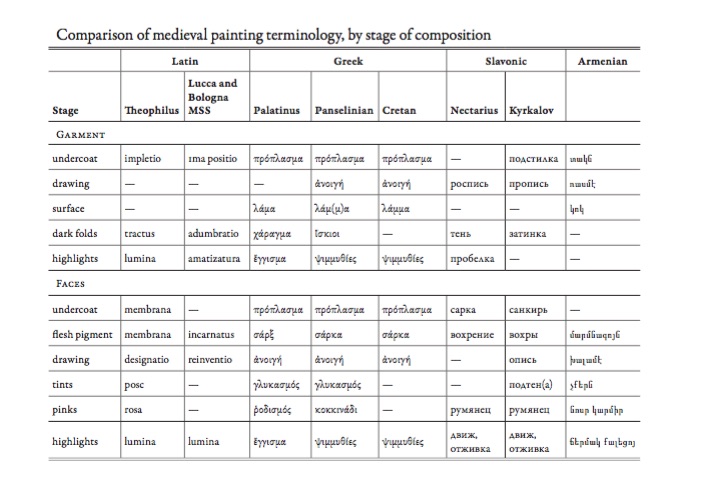
This correspondence among independently written texts stems from the basic properties of tempera, which a modern author describes as follows:
In contrast to oil paint, which can be applied with a large brush and large strokes, tempera dries quickly and must therefore be applied in one stroke; it can neither be blended nor manipulated with the brush while wet, neither can much impasto be created. . . . Modelling and blending of tones therefore have to be built up with many layers of superimposed brush strokes.
The essential similarity of procedure does not, of course, mean that no variation of artistic technique was possible in practice: the Palatinus Instruction alone describes two different methods for painting garments; the technical peculiarities of individual icon painters or painting schools can be probably studied by examining their works. Nevertheless, stylistic variety was inherently limited by the nature of the tempera medium. In a short and fundamental article about the technique of icon painting L. A. Durnovo lists the main respects in which noteworthy variation does occur:
1. the color, thickness, and transparency of the undercoat;
2. linear versus so outlines and features;
3. the color, quantity, and position of shadows;
4. the width, thickness, color, position, and manner (owing or stippled) of tonal transitions;
5. the number, length, and harshness (respectively softness) of highlights;
6. the presence (respectively absence) of facial pinks, the character of these pinks and of the color drawing for certain facial features;
7. the color and treatment of the eyes.

The more general significance of the Palatinus Instruction as a source for the history of painting can be addressed here only briefly and will, we hope, be discussed by others in the future.
Ancient Greek had special vocabulary for describing σκιαγραφία, the way painters depict unevenly lit surfaces. None of it is found in the Palatinus,
where the very word σκιάζειν evidently refers not to the shading of forms but to their preliminary outlining by way of underdrawing. All other technical terms in the Instruction are of purely medieval origin. is novel wording indicates a change in the way in which depiction was conceptualized. The author of the Palatinus text thinks not in terms of reproducing the effect of the light reflected by a given surface (the position of the light source relative to the depicted object is of no importance to him) but rather, of gradually articulating forms through the layering of pigment and thus building them, as it were, from the inside out. By this logic, a painted face is “solidified” (ποιεῖν στερεόν), facial features are then “opened” (ἀνοίγειν) onto it, and its shiny spots are “approximated” (ἐ ίζειν), as are the ridges of garment folds. e sides of the face are described not as convex surfaces but as concentric circles gradually narrowing toward the top (ἄκρον) of the cheeks. Any impression of depth that such painting produces is based on the observation, expressly formulated in late antiquity and evidently endorsed by Byzantine painters, that pale colors on a at surface normally appear to be closer to the viewer than the adjacent dark ones.
Once the concept of “the reception of light” (del ricevere de’ lumi) had been consciously readopted in the Renaissance, the process of painting could no longer be envisioned as consecutive layering of pigment and the very medium of egg tempera became increasingly inadequate. Dionysios of Fourna’s eighteenth-century Manual, which anachronistically speaks of “natural coloring” in Palaiologan painting, also contains a section about painting νατουράλε, on cloth with oils.
Georgi R. Parpulov
ul. Neophyt Rilski 12
4003 Plovdiv
Bulgaria
gparpulov@abv.bg
Irina V. Dolgikh
Ruth E. Bubb Conservation of Paintings
Poplars Farmhouse
63 Main Road, Middleton Cheney Banbury OX17 2LU
United Kingdom
mirumir74@yahoo.com
Peter Cowe
UCLA NELC
Box 951511 / 368 Humanities
Los Angeles CA 90095-1511, USA
cowe@humnet.ucla.edu
To download a PDF copy of this page WITH FOOTNOTES! click here.

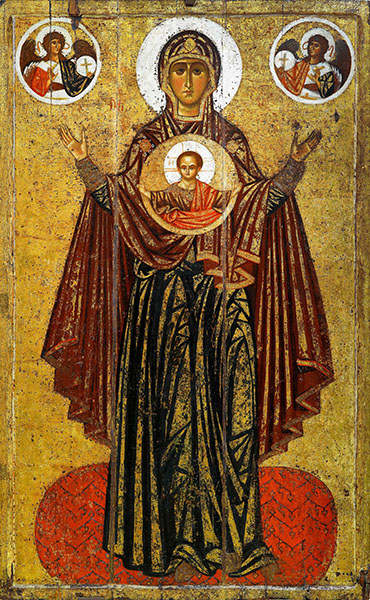 The Great Panaghia
The Great Panaghia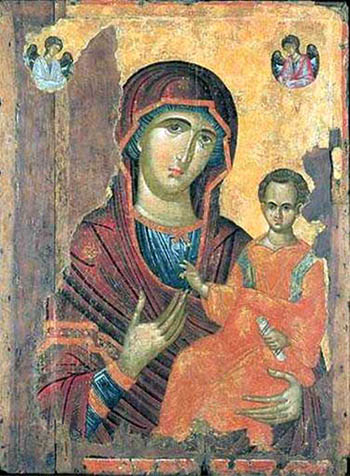 Hodegetria
Hodegetria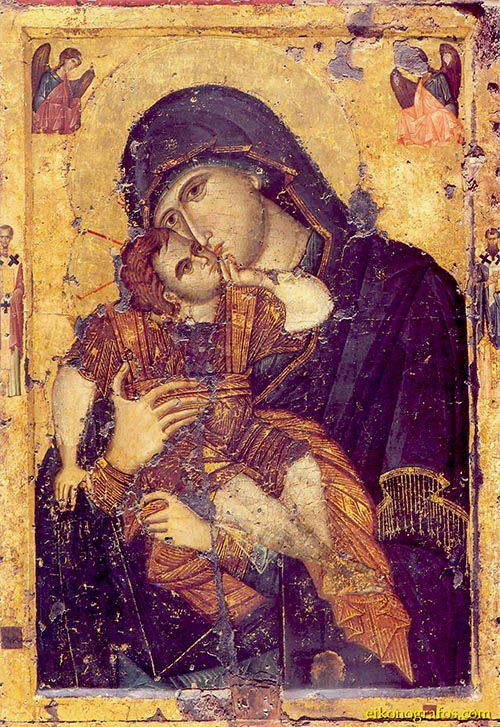 The Playing Child
The Playing Child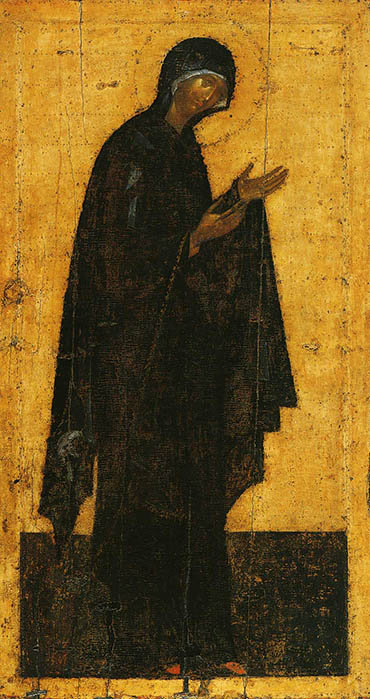 Andrei Rublev Theotokos
Andrei Rublev Theotokos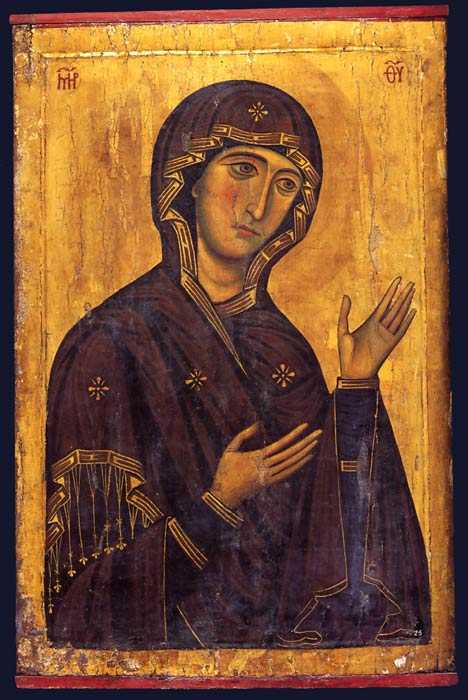 Sinai Theotokos
Sinai Theotokos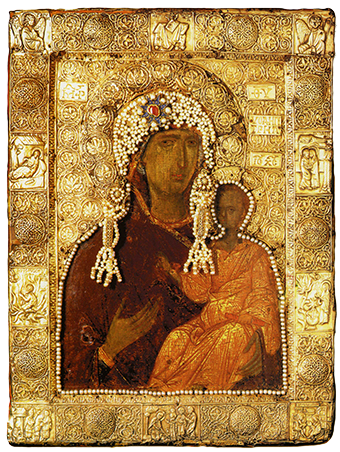 Hodegetria
Hodegetria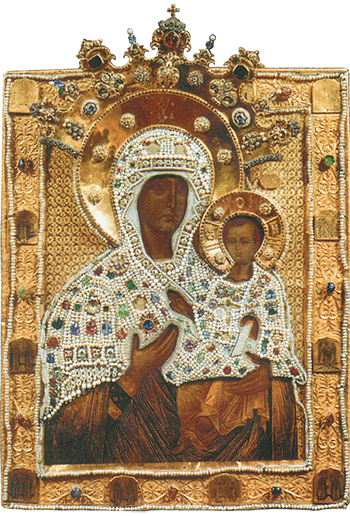 Hodegetria
Hodegetria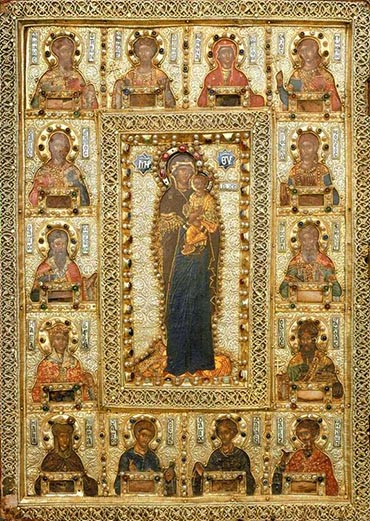 Palaiologian Reliquary
Palaiologian Reliquary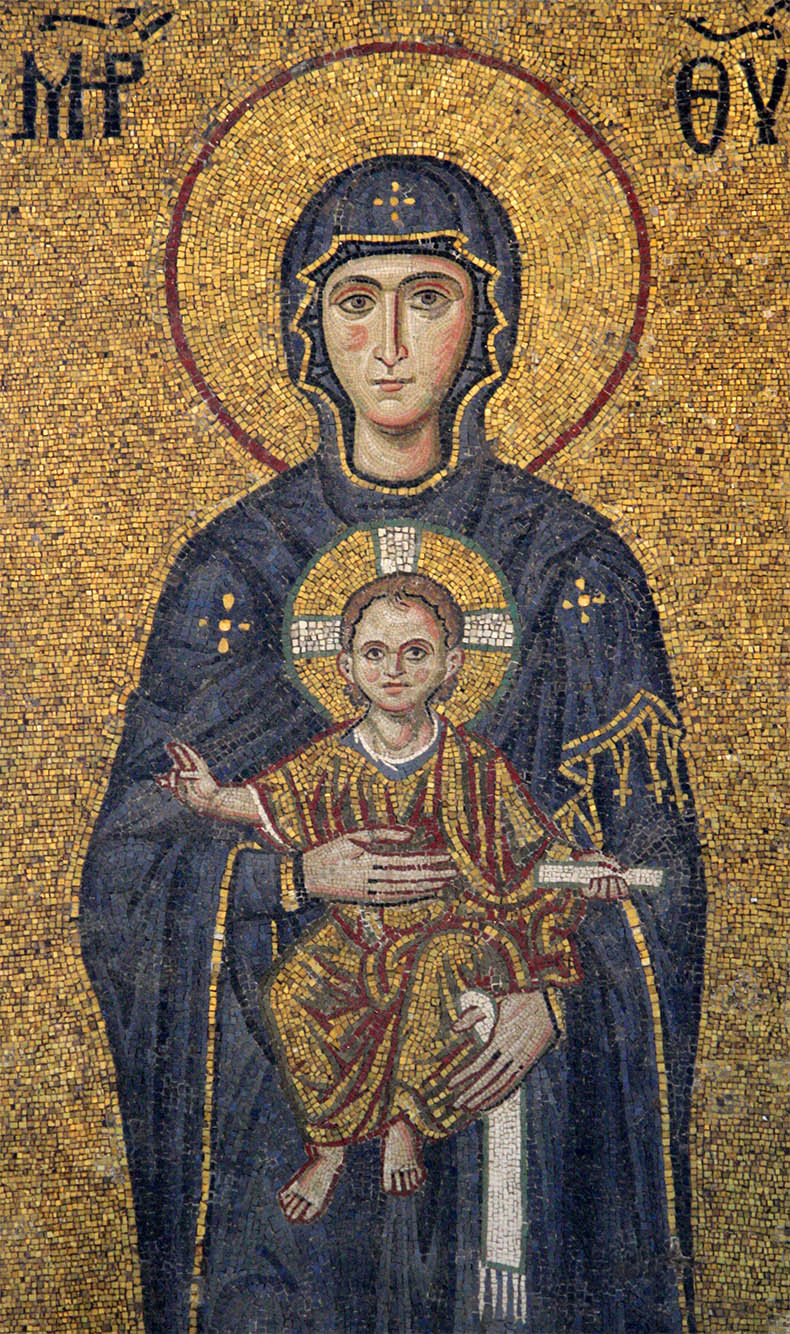 Hagia Sophia Theotokos
Hagia Sophia Theotokos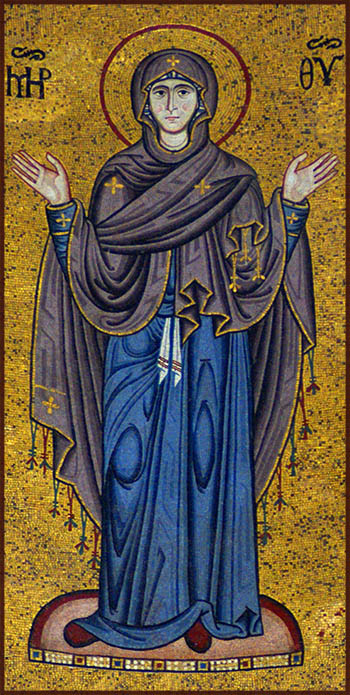 Cefalu Theotokos
Cefalu Theotokos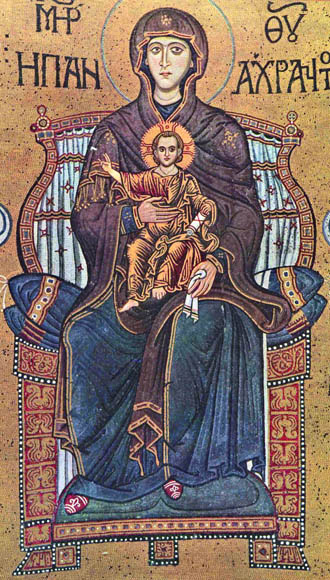 Monreale Theotokos
Monreale Theotokos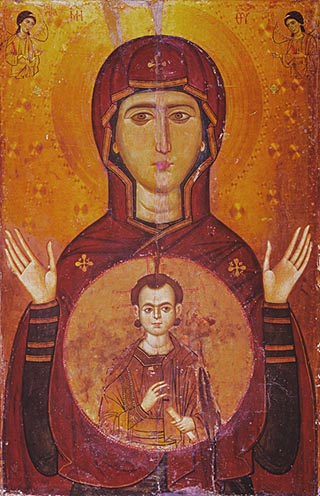 Theotokos Blachernitissa
Theotokos Blachernitissa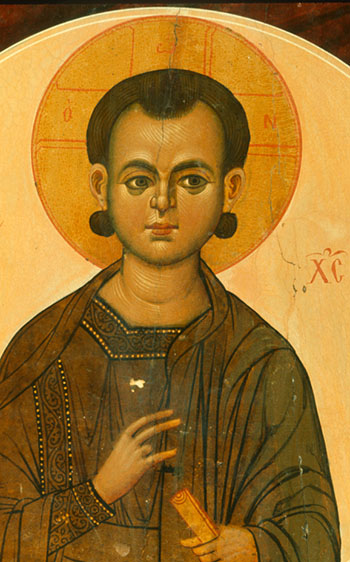 Here is a close-up showing Christ. He is always shown having high forehead like this. Here we can also see two curls, one on each side of his neck. Compare this to the head of Christ in the Mellon icon and you can see how the restoration botched the shape of the head and the hair.
Here is a close-up showing Christ. He is always shown having high forehead like this. Here we can also see two curls, one on each side of his neck. Compare this to the head of Christ in the Mellon icon and you can see how the restoration botched the shape of the head and the hair.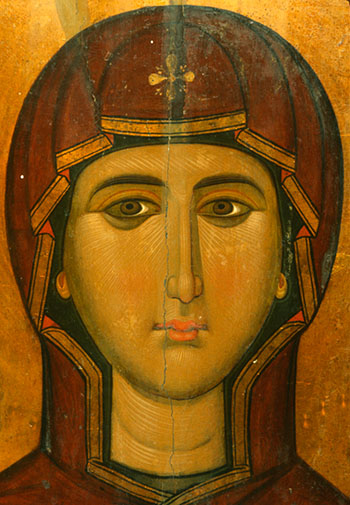
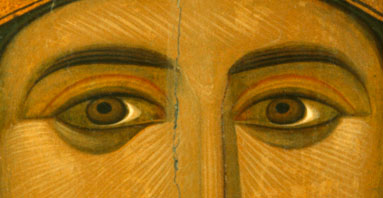 The three previous pictures were taken before the icon was restored, removing later touch-ups. This icon is really large, the highlights have been applied in many broad strokes.
The three previous pictures were taken before the icon was restored, removing later touch-ups. This icon is really large, the highlights have been applied in many broad strokes.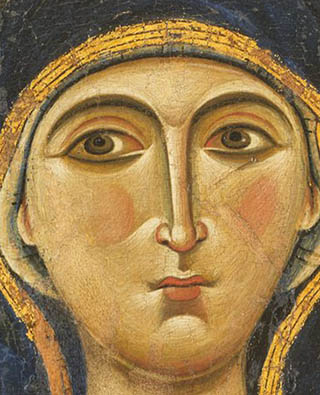







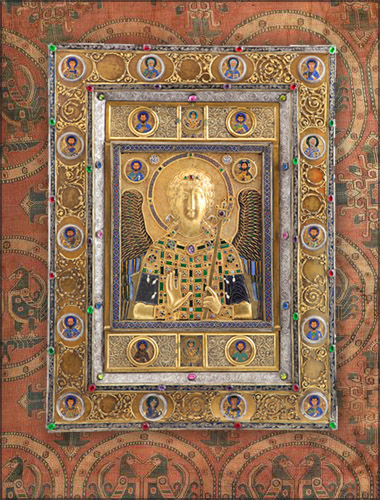

 click here for icons of christ
click here for icons of christ click here for icons of the theotokos
click here for icons of the theotokos click here for icons of angels
click here for icons of angels click here for icons of saints
click here for icons of saints








